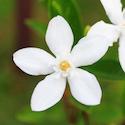If you are a fan of gardening and plant decoration, then you are probably familiar with two of the most beloved and stunning plants: jasmine and bougainvillea. Jasmine plants are known for their beautiful, fragrant flowers and their ability to attract bees, butterflies, and hummingbirds as we have learnt over the posts in this blog.
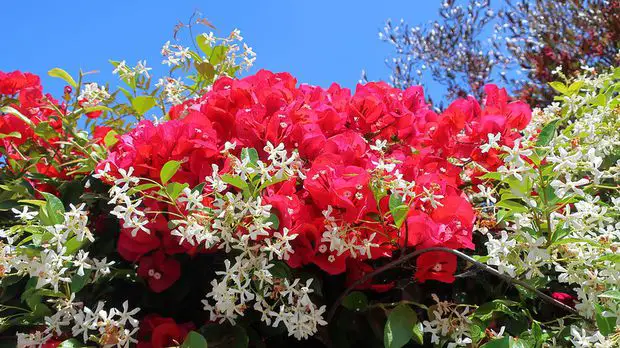
Meanwhile, bougainvillea plants are loved for their showy, bright and vibrant flowers in shades of pink, purple, red, and orange. Both of these plants are popular among gardeners and plant enthusiasts and for good reason. But have you ever wondered: “Can you plant jasmine and bougainvillea together?”
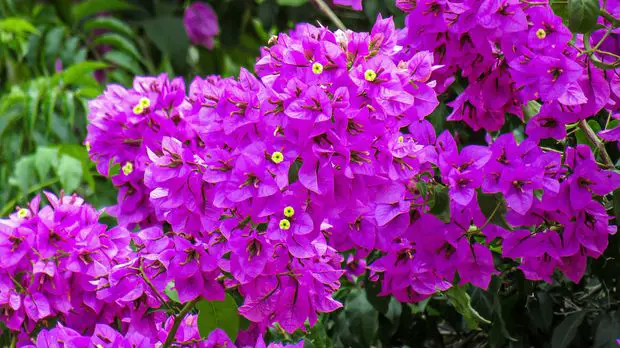
Yes. Planting jasmine and bougainvillea together is not only possible but can also have some amazing benefits. After all, they both have similar requirements for sunlight, water, and soil.
In this article, we will explore whether you can plant jasmine and bougainvillea together, the benefits of doing so, and how to care for them once they are planted together. If you are looking to add a little extra beauty and fragrance to your garden, keep on reading!
Can jasmine and bougainvillea be planted together? Considerations to keep in mind
Now, let’s dive into the big question - can you plant jasmine and bougainvillea together? The short answer is yes, you can. Both plants have similar requirements for sunlight, water, and soil, making them compatible planting partners. However, there are a few considerations to keep in mind when planting them together:
- First and foremost, make sure you have enough space. You will need to consider the available space in your garden before planting these two together. Jasmine and Bougainvillea have different growth habits. Jasmine is a climbing vine that can reach up to 15 feet in length, while bougainvillea is a sprawling shrub that can spread up to 30 feet.
- Bougainvillea is a fast-growing vine that can quickly overtake and smother other plants if not given enough room to grow. Jasmine, on the other hand, is a shrub that grows more slowly but can still take up a lot of space if left unchecked.
- Both plants have different water and nutrient requirements. Jasmine prefers consistently moist soil, while bougainvillea likes to dry out a bit between watering. It is important to find a balance between the two when watering them together.
- Bougainvillea is a sun-loving plant, while jasmine prefers some shade. So, when planting them together, make sure to choose a spot that gets plenty of sunlight but also has some shade throughout the day.
- Bougainvillea is a bit more high-maintenance than jasmine. It requires regular pruning to keep it under control and prevent it from getting too leggy. If you are up for the challenge of caring for both plants, then go ahead and plant them together!
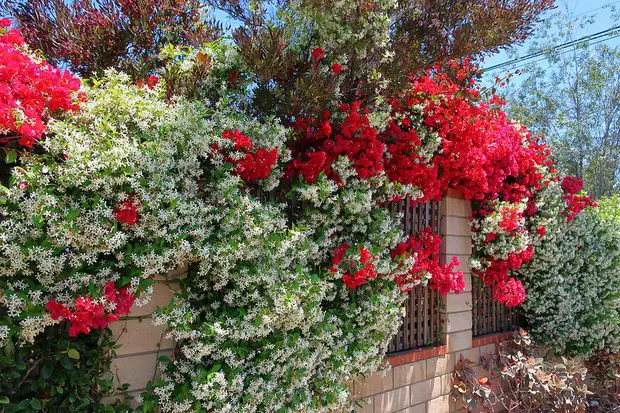
Benefits of planting jasmine and bougainvillea together
Planting jasmine and bougainvillea together can have many benefits for your garden. For one, they complement each other nicely in terms of appearance. The bright and vibrant flowers of the bougainvillea can provide a stunning backdrop to the delicate and fragrant blooms of the jasmine. Together, they can create a beautiful and dynamic landscape.
Another benefit of planting these two plants together is that they can help each other grow better. Bougainvillea plants are known for their strong roots, which can help stabilise the soil around them. This can be beneficial for jasmine plants, which prefer moist soil and can benefit from a stable soil environment.
In turn, the jasmine plant can help provide shade and a more controlled environment for the bougainvillea, which can be sensitive to extreme temperatures and harsh sunlight. Another beautiful benefit of planting these amazing shrubs together is that jasmine plants are well-known for their ability to attract bees, butterflies, and hummingbirds, while bougainvillea flowers are a favourite among butterflies and other pollinators. Planting these two together can help create a vibrant and thriving environment for wildlife in your garden!
The beauty of being a gardener is that you can experiment with different planting conditions, for example, if you were to explore the different varieties of both jasmine and bougainvillea, you could play with their blooming season and that way by planting them together, you could enjoy a longer season of blooms and colour in your garden.
Drawbacks of planting jasmine and bougainvillea together
While there are many benefits to planting jasmine and bougainvillea together, there are also some drawbacks to consider that unfortunately, we, gardeners need to be aware of:
- Both jasmine and bougainvillea require a lot of water and nutrients to grow, and planting them together can sometimes result in competition for resources! This can lead to stunted growth, reduced flowering, and even plant death in extreme cases.
- As mentioned earlier, bougainvillea is a fast-growing plant that can spread quickly and take over the garden if not properly maintained. When planted with jasmine, the bougainvillea's fast growth can sometimes overshadow the jasmine, leading to an uneven and unbalanced look in the garden.
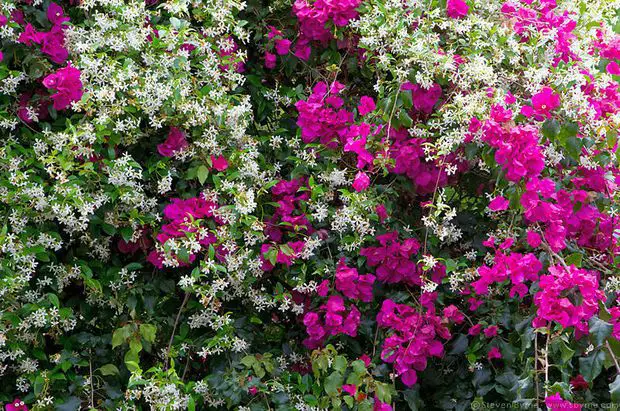
This is the reason why although the end result of planting these two beauties together is awesome, it is quite involved as they both require regular maintenance to thrive.
Jasmine needs to be pruned regularly to promote healthy growth and prevent overgrowth, while bougainvillea needs to be pruned to maintain its shape and prevent it from becoming too dense.
How to plant jasmine and bougainvillea together. Tips on how to do it
Planting jasmine and bougainvillea together can be a great way to add some colour and fragrance to your garden. However, to ensure the success of these plants, there are some key considerations to keep in mind. Here are some tips on how to plant jasmine and bougainvillea together:
Choose the right location
Both jasmine and bougainvillea prefer full sun, so make sure to plant them in an area that receives at least six hours of direct sunlight per day. Don’t forget to make sure the area has well-draining soil to prevent water-logging, otherwise, it will be game over!
Soil requirements
Jasmine and bougainvillea both prefer slightly acidic soil with a pH between 5.5 and 6.5. To prepare the soil, mix in compost or other organic matter to improve drainage and fertility.
Adding compost or other organic matter to the soil helps improve its texture, which in turn allows for better drainage and aeration of the roots of both jasmine and bougainvillea plants.
Adding the right organic matter is crucial as it provides important nutrients and minerals to our plants of interest, promoting healthy growth and vibrant blooms.
Don’t forget to mix in enough compost or organic matter when preparing the soil for planting our Jasmine and Bougainvillea. This is to create a loose and crumbly texture that will allow the roots to easily spread and access the nutrients they need to thrive.
If you get confused with numbers and proportions just remember that a good rule of thumb is to use about 2 to 3 inches of compost per 6 inches of soil.
Examples of the organic matter you can use for this purpose:
- Composted manure
- Peat moss
- Leaf mold
- Worm castings
- Composted kitchen scraps
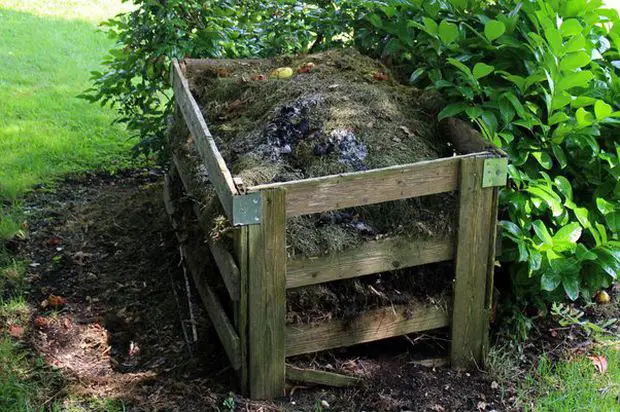
Watering needs
Both plants need regular watering to establish themselves and grow properly. Be careful not to overwater, as this can lead to root rot and other problems. Water your jasmine and bougainvillea plants deeply once a week during the growing season (spring and summer), and reduce watering to once every two to three weeks during the dormant season (fall and winter).
Water the plants deeply enough to saturate the root zone, but avoid letting the soil become waterlogged, which can cause root rot.
Trellis or support
Bougainvillea is a climbing plant that needs support to grow properly. Provide a trellis or other support structure for the bougainvillea to climb on, but make sure it is sturdy enough to support the weight of the plant as it grows.
Pruning
Prune your plants in the late winter or early spring before new growth begins. Jasmine should be pruned after flowering, while bougainvillea can be pruned at any time of the year to maintain its shape and size. For your bougainvillea, prune more aggressively to keep it under control and encourage blooming.
Use clean, sharp pruning shears to remove any dead or damaged branches, and cut back any overgrown branches to encourage new growth. It helps prevent the spread of diseases by avoiding the nasty transfer of bacteria or fungi from one plant to another.
It might seem too obvious but worth mentioning the importance of using sharp pruning shears! This is to make cleaner cuts as dull pruning shears can crush and tear the plant tissue, which can lead to slower healing and an increased risk of diseases and the attraction of pests.
Which tools can you use for this?
- Gardening gloves to protect your hands while working with soil and plants.
- A trowel or garden spade to dig holes for planting.
- Pruning shears or loppers to trim back any overgrown branches and maintain the shape and size of the plants.
When looking for pruning shears, choose a pair that is comfortable to hold and has a sharp blade. Look for shears with a bypass cutting blade rather than an anvil blade, as bypass blades are better for cutting live plants.
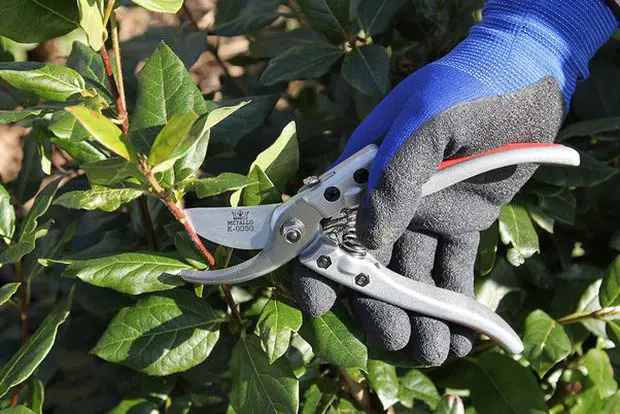
You can find pruning shears at your local garden centres or online retailers such as Amazon or Gardener's Supply Company. It is important to maintain the cleanliness and sharpness of your pruning shears by cleaning them with rubbing alcohol or a bleach solution between each use and sharpening the blades regularly.
- A watering can or garden hose to water the plants regularly.
- A trellis or support structure for the bougainvillea to climb on.
- Soil amendments or fertilisers
How to maintain and care for Jasmine and Bougainvillea together. Tips on how to do it
When it comes to fertilising jasmine and bougainvillea plants, it's important to choose a balanced, all-purpose fertiliser every 4-6 weeks during the growing season (spring and summer). Avoid fertilising during the dormant season (fall and winter) as this can stimulate growth when the plants are not actively growing.
When applying the fertiliser, make sure not to over-fertilise as it can cause damage to your plants and even kill them. Applying a balanced, all-purpose fertiliser that contains equal amounts of nitrogen, phosphorus, and potassium, such as fertiliser 10-10-10 or 20-20-20 is essential.
This will help ensure that your plants receive the proper nutrients they need to thrive. Nitrogen helps with leaf and stem growth, phosphorus aids in root development and flower production, and potassium helps with overall plant health and disease resistance.
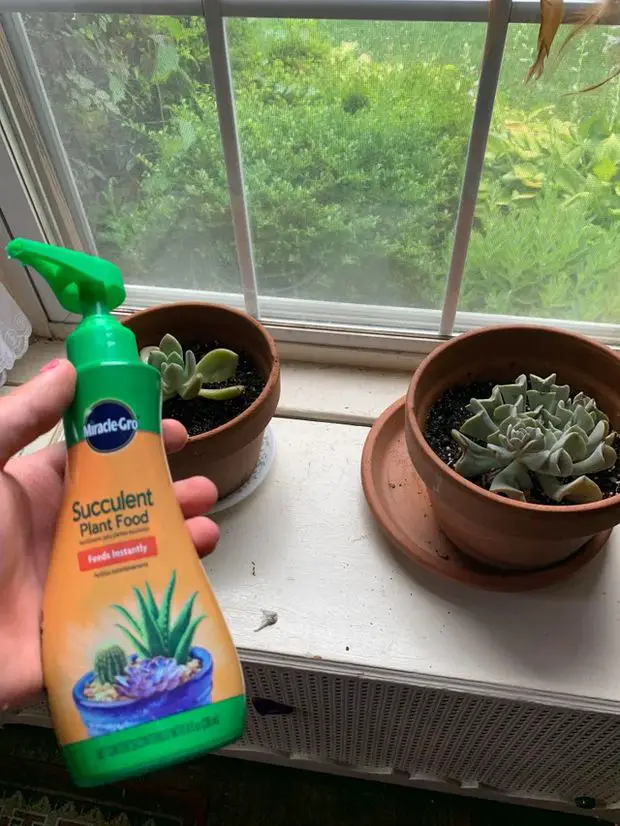
These fertilisers can be found at most gardening stores or online retailers. Some examples of all-purpose fertilisers that can be used for jasmine and bougainvillea include Miracle-Gro All Purpose Plant Food, Jobe's Organics All Purpose Fertiliser, and Espoma Plant-tone All Purpose Organic Fertiliser. These fertilisers are formulated with the necessary nutrients to promote healthy plant growth and can be easily found at most gardening stores or online.
When it comes to inspecting your plants, (and you definitely have to do this regularly) make sure you check their leaves on both sides as well as the branches and the soil bed. Both jasmine and bougainvillea are relatively pest and disease-resistant but by planting them together the risk of trespassing pests and other diseases to each other, increases.
As soon as you spot some issues such as mites or other pests, treat your plants promptly! For pests, use insecticidal soap or neem oil to control aphids, spider mites, and mealybugs. For diseases, use a fungicide to control fungal leaf spots and powdery mildew.
When using any type of pesticide or fungicide, it is important to follow the instructions on the package carefully and to wear protective clothing, such as gloves and a mask, to avoid overexposure.
Lastly, it is pivotal to avoid spraying pesticides or fungicides on windy days or when the temperature is very hot or cold, as this can affect their effectiveness.
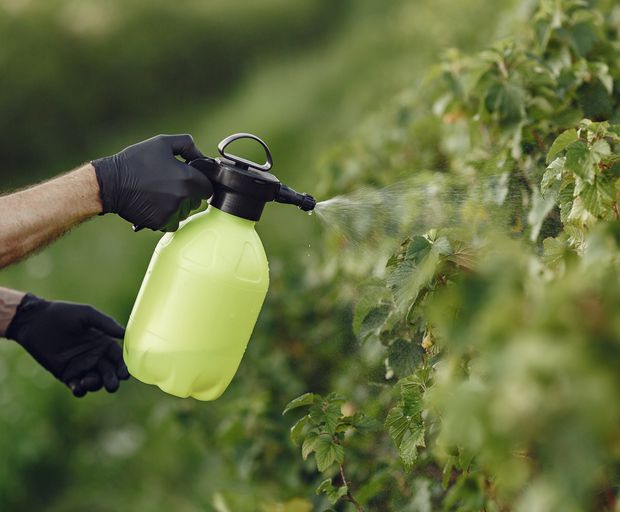
How far apart should jasmine be planted?
When planting jasmine and bougainvillea together, as mentioned above, it is important to consider the spacing between them to ensure that they have enough room to grow and bloom.
The plants should be spaced at least 3 to 5 feet apart, that way you can ensure that they have enough space to grow and develop without hindering each other's growth. This spacing also allows for adequate air circulation around the plants, which can help reduce the risk of fungal diseases.
Keep in mind that the exact spacing between your plants may depend on the specific cultivars or varieties of jasmine and bougainvillea that you are planting, as some varieties may grow larger or smaller than others. It is always a good idea to check the plant tags or consult with a gardening expert for specific advice on spacing for your particular plants.
When plants are crowded together, they may be more susceptible to pests and diseases. This is because pests and diseases can easily spread from plant to plant in close quarters. On top of that, a lack of air circulation around the plants can create a humid environment, which can encourage the growth of fungal diseases.
When plants are overcrowded, it can make it difficult to perform maintenance tasks such as pruning, fertilising, and pest control. This can make it challenging to keep the plants healthy and looking their best. Thus, causing aesthetic issues.
What plants also pair well with bougainvillea?
As a passionate gardener, I have experimented with different plant combinations in my garden over the years. One of my favourite plants to pair with bougainvillea is obviously Jasmine! read above to learn how to do it!
Also, you can learn what else pairs well with Jasmine here: What plant goes well with jasmine?
Besides Jasmine, Bougainvillea pairs excellently with hibiscus. The vibrant colours of the hibiscus flowers complement the bright hues of the bougainvillea, creating a stunning and eye-catching display. Hibiscus plant requires similar growing conditions to bougainvillea, including well-draining soil, plenty of sunshine, and regular watering.
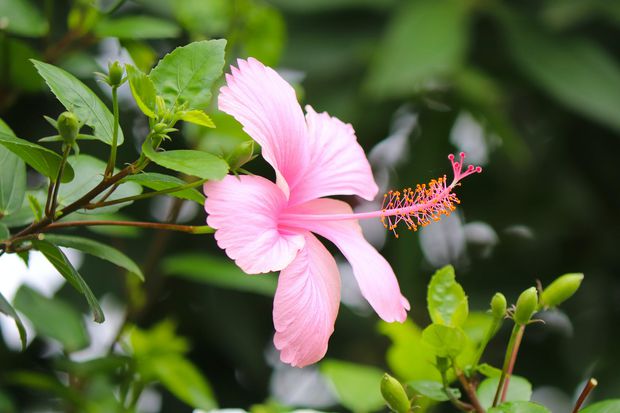
Another plant that pairs well with bougainvillea is the creeping fig. This trailing vine has small, heart-shaped leaves that add a contrasting texture to the bold, papery flowers of the bougainvillea. Creeping fig is also a great plant for creating a living wall or fence as it attaches itself to surfaces using small adhesive pads on its stems.
If you are looking for a plant to provide some shade for your bougainvillea, consider planting a tall palm tree nearby. The spiky leaves and rough bark of the palm tree contrast nicely with the soft, colourful petals of the bougainvillea flowers. I personally feel that palm tree additions to your Bouganvillae are an excellent choice as it provides a natural shade source, protecting the bougainvillea from excessive sun exposure during the hottest parts of the day.
Lastly, another plant that pairs well with bougainvillea is the lantana. This hardy plant produces clusters of small, colourful flowers that complement the bold, showy blooms of the bougainvillea. Lantana is also an excellent plant for attracting pollinators such as bees and butterflies to your garden.
Final thoughts
There you go! now you know that jasmine and bougainvillea can make beautiful companions in your garden! By following the tips I have provided, you can prepare the soil properly and give your plants the best possible chance to thrive.
Whether you are a seasoned gardener or just starting out, mixing in the right compost or other organic matter can help you create a thriving garden full of colour and fragrance.
Go ahead and plant those jasmines and bougainvillea together - you won't be disappointed!
